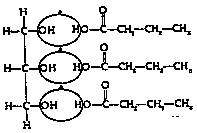Lipids
*They are organic molecules non-dissolvable in
H2O.
*Lipids contain many C-H bonds which store energy
(calories).
Most contain fatty acids (long chains of C-H bonds ending in COOH) which are
then bonded to Glycerol.
Saturated Fatty Acid (F.A.)- all bonds are C-C
or C-H. Contains more energy, thus more fattening.

Unsaturated F.A.- some bonds may be C=C. Contains
less energy, less fattening.

Types of Lipids:
A. Triglycerides: Made of glycerol & 3 fatty
acids. (EX. Fats & oils)
 ---or---
---or---
B. Phospholipids: Glycerol, 2 fatty acids,
& 1 phosphate group (PO4). (Ex.-Cell membranes)
 ------or---
------or---
C. Wax: Fatty Acid & an alcohol group (OH).
D. Steroids: Consist of four 5- or 6-sided
carbon rings joined together. Has no fatty acids. (Ex.- Cholesterol, hormones)

A simple diagram of a steroid.
Importance of Lipids:
1. Energy storage- Fats store glucose energy for long time periods. Highest
calorie values per weight.
2. Chemical messengers- Steroid hormones (testosterone & estrogen)
3. Cell membranes (flexible, protective outer covering of cells).
Slichter



---or---
------or---